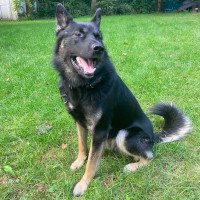Appearance of the Akita Shepherd
|
| The Akita Shepherd has the body of a German Shepherd and the face and tail of an Akita Inu. Bear in mind, however, that as this breed is not stabilized, it can inherit any combination of physical traits from its parent breeds. Nevertheless, Akita Shepherds generally have medium-sized erect ears, dark triangular eyes and a scissor-like muzzle. They also have the characteristic Spitz tail, which curls upwards and is covered in plush. Their body is muscular and strong, with the sloping back of a German Shepherd. The Akita Shepherd's dense coat is generally of medium length and comes in several colors common to both parent breeds. Dogs with shepherd heritage also inherit light or heavy dark markings around the face and muzzle. |
Temperament of the Akita Shepherd
|
| The Akita Shepherd is a very serious breed, reserved and aloof like both its parents. He has a natural inclination to guard and protect, and his personality reflects this impulse in most situations. However, when at ease, Akita Shepherds can be very energetic and playful. Nevertheless, these dogs are not very good with strangers, other animals or young children. Although they are loyal and gentle with their loved ones, they can be aggressive if they feel threatened or unsure of themselves. As pets, Akita Shepherds need to be trained firmly and consistently, otherwise this highly nervous breed will dominate those around them. For the same reason, early socialization is very important in raising a well-adapted Akita Shepherd. In addition, Alaskan Shepherds are quite intelligent and can be trained to respond to relatively complex commands and tasks. They value their independence, but are happy to relax alongside their owners at the end of an ideally active day. |
Needs and activities of the Akita Shepherd
|
| Shepherd and Spitz breeds are known for their strength of character and work ethic; the Akita Shepherd is no exception. Ideally, Akita Shepherds will spend at least 60 minutes a day exercising in a cool climate. They like to have a task to accomplish. That's why these dogs will happily follow their owners on hikes, runs or other expeditions. Because they're so adventurous, Akita Shepherds adapt best to rural or suburban areas where they have access to large tracts of land to explore and roam. Akita Shepherds are also highly intelligent and require a certain level of mental stimulation. Indoor games and activities can satisfy this need. |
Maintenance of the Akita Shepherd
|
| Akita Shepherds are not hypoallergenic and are not suitable for pet owners with allergies. Their coats shed moderately and require weekly brushing (at least) to stay clean, shiny and well-groomed. For grooming, owners can use a variety of tools, including a long-hair brush or a pimple brush, depending on the length of their pet's coat (pimple brushes are designed for longer coats). Apart from that, Akita Shepherds are fairly easy to care for, needing only occasional baths and monthly or fortnightly nail trims. The most difficult part of caring for an Akita Shepherd is regularly checking its coat and ears for debris, and brushing its teeth daily. |









 English (United Kingdom)
English (United Kingdom)